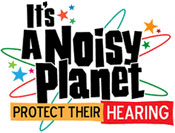
For Immediate Release
Thursday, October 2, 2008
10:00 a.m. EDT
Contact:
Patricia Blessing
(301) 496-7243
blessinp@mail.nih.gov
Jennifer Wenger
(301) 496-7243
jwenger@mail.nih.gov
NIDCD Launches Campaign to Protect the Hearing of Tweens
New Web Site Offers Parents Resources to Help Tweens Avoid Hearing Loss from Noise
A new campaign to help parents of 8- to 12-year-olds teach their children how to avoid hearing loss from overexposure to loud noise was launched today by the National Institute on Deafness and Other Communication Disorders (NIDCD), part of the National Institutes of Health. The new campaign, called It’s a Noisy Planet. Protect Their Hearing., features a new Web site that offers advice to parents on the causes and prevention of noise-induced hearing loss, how to recognize when a child’s hearing is at risk, and ways to reduce noise exposure. The site contains games, posters, and interactive information about noise and hearing loss tailored specifically for tweens.
“Noise is everywhere, and children and adults alike are at risk for hearing loss from overexposure,” said James F. Battey, Jr., M.D., Ph.D., director of the NIDCD. “Our goal through this campaign is to increase awareness among parents and children so that it will become second nature to use protective hearing techniques when they’re exposed to loud noise, just like it’s become second nature for many people to wear sunscreen when they’re at the beach or to snap on a helmet when they go biking.”
Children often are exposed to noises that can reach harmful levels and durations. Doing yard work, such as using a power mower, playing a musical instrument, whether it’s a violin or electric guitar, or attending a sports event in a large stadium can be the source of too much noise.
Noise-induced hearing loss occurs when too much noise damages small sensory cells in the inner ear, called hair cells. Once damaged, these hair cells cannot be repaired. Hair cells can be injured instantly by an intense blast of noise, such as the bang of a firecracker, or gradually from repeated exposure to excessive noise. Overexposure to noise also may cause tinnitus, a ringing, roaring, or clicking sound in the ear. Research also suggests that genetics may play a role in increasing a person’s vulnerability to noise-induced hearing loss.
The campaign targets tweens because they are at an age when they are no longer little children, and they are beginning to develop a sense of who they are and what they like to do. Reaching them at this age, while they’re forming attitudes and habits related to their health, will help them understand that healthy hearing habits will benefit them for a lifetime.
The Noisy Planet campaign advocates three ways to prevent NIHL:
- Block the noise by wearing earplugs or protective earmuffs, like those used by airport or lawn service workers.
- Avoid the noise by walking away or limiting time spent in noisy environments.
- Turn down the sound on the growing number of tools, toys, and gadgets that add to the increasing noise level of daily life.
Information on NIDCD’s Noisy Planet campaign is available at www.noisyplanet.nidcd.nih.gov.
NIDCD, which celebrates its 20th anniversary in 2008, supports and conducts research and research training on the normal and disordered processes of hearing, balance, smell, taste, voice, speech and language and provides health information, based upon scientific discovery, to the public. For more information about NIDCD programs, see the Web site at www.nidcd.nih.gov.
The National Institutes of Health—The Nation's Medical Research Agency — includes 27 institutes and centers and is a component of the U.S. Department of Health and Human Services. It is the primary federal agency for conducting and supporting basic, clinical and translational medical research, and it investigates the causes, treatments and cures for both common and rare diseases. For more information about NIH and its programs, visit www.nih.gov.